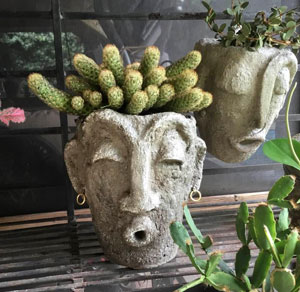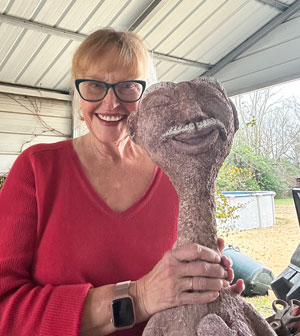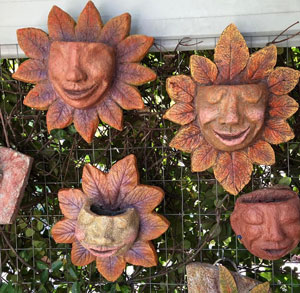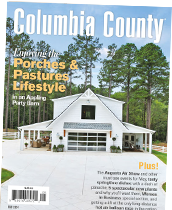
Photos courtesy of Michelle Scarborough Johnson
From fairies to potheads (literally), this yard art is an expression of personality and playfulness.
There’s no rest for makers like Michelle Scarborough Johnson, who has been creating yard art and garden sculptures for the past 10 years.
Her creative juices never stop flowing – even in her sleep.
“I’ll wake up in the morning with an idea and think, ‘I could do this,’” Michelle says.
The retired critical care nurse makes her pieces out of hypertufa, which is a lightweight, porous, manmade rock consisting of Portland cement and aggregates such as vermiculite, perlite, peat moss or sand. She mixes up the cement-based substance, which is a substitute for a porous type of limestone called tufa, herself using a recipe she found online.
“I honestly don’t remember where I saw it, but I taught myself,” Michelle says.
Recycled and Refurbished
Yard art is just the latest creative endeavor for this self-taught artist.
“I sew a lot. I paint. I quilt,” Michelle says. “I always wanted to make pottery, but you need a kiln. I love gardening.”
When Michelle was 10 years old, her grandmother taught her how to sew. Otherwise, however, she taught herself the other crafts.
“It’s very fulfilling for me to be making something all the time,” says Michelle, a mother of six who earned her nursing degree at age 42.
She makes hats out of refurbished materials, and for every hat she sells, she donates one to someone in need.
She also incorporates discarded and recyclable materials such as wine bottles, plastics, metal hardware, balloons, ice cream containers, milk jugs and strips of fabric into her hypertufa projects.
“I wrap the bottles in old clothes that can’t be donated,” says Michelle. “I dip the fabric in cement. As it dries, I build it on top of the mixture.”
Her tools include old screwdrivers, picks, a drill and paintbrushes. “I just make do with what I have,” she says.
 Fairies and Potheads
Fairies and Potheads
Michelle hand-molds her pieces, and she works in her outdoor studio on her 2-acre property in Blythe. Some of her favorite things to make are fairies and “potheads,” which are head-shaped planters.
“I talk to them while I’m making them,” Michelle says. “Some of them are kind of flirtatious. They have smoochy lips. The snarky ones have sly smiles. They develop a personality as I’m making them. I feel like people want to buy them when they see something in them. I don’t make their personality. I just let it evolve.”
Although each fairy and pothead has its own personality, they have a lot of similarities in their faces because of the way Michelle molds them. In addition, they generally have one characteristic in common. Most of them have their eyes closed.
“They look peaceful to me,” Michelle says. “I’ve done them with their eyes open, but they don’t look as happy.”
She rarely names her creations, either. “I let everybody choose what they want to call their pothead,” she says.
One of her fairies, which has rosy cheeks and wings, a blue dress and hair made of bed springs, has been selected for inclusion in the Greater Augusta Arts Council’s WetPaint Party & Art Sale on Friday, March 8.
To make fairy wings, she casts elephant ears or various leaves that she finds in her garden. “I use old jewelry on the fairies,” Michelle says. “I used to make jewelry, so I have a lot of jewelry supplies.”
 To make a pothead, she starts with a balloon that she wraps in strips of cement-dipped fabric. Once it dries, she turns it upside down to drill a hole in the bottom.
To make a pothead, she starts with a balloon that she wraps in strips of cement-dipped fabric. Once it dries, she turns it upside down to drill a hole in the bottom.
While Michelle can shape a piece in an hour or two, it can take a few days to finish the yard art because the work has to be done in stages. However, she says she can spend a month making a garden fairy.
Texture and Color
Michelle also paints her hypertufa pieces with acrylics, and after drying and curing them, she seals them with concrete so they can withstand the elements.
“I love texture and color,” she says. “They’re just so natural and pretty.”
She likes secondary colors such as purple, teal and orange, and she highlights textures with off-white paint. However, she tries to make her pieces look natural in their outdoor setting.
 “I want them to look like they belong there, but I also want them to stand out,” Michelle says.
“I want them to look like they belong there, but I also want them to stand out,” Michelle says.
She paints the elephant ears, which she also uses to make yard art such as birdbaths, a different color from the grass to make them stand out. In addition, she makes totem poles by putting a piece of rebar in the ground and stacking it with hypertufa pieces that she makes one at a time.
Six years ago, she spent the entire summer building a pathway with pavers she made out of cement to connect the greenhouses in her garden.
Although she doesn’t use her nursing skills in her craft, she has found that it takes a combination of art and science to create a piece.
She needs to use the correct proportions of aggregates when she mixes the hypertufa so it doesn’t crumble. Anatomy also comes into play when she makes fairies and potheads because “the ears need to be equal with the eyes.”
In addition, she says, “My pieces are not anatomically correct, but that’s part of the fun of it.”
 Creativity and Connection
Creativity and Connection
Michelle started a Facebook page called Hypertufa Heffas, which is named after the heifers that graze in a field behind her property. She sells most of her work on various Facebook sites or by word-of-mouth.
“It’s fun when somebody really loves a face and they connect with it somehow,” Michelle says. “Sometimes the personality speaks to them. I love that somebody loves a piece.”
She teaches group and private classes and hosts parties at her outdoor studio when the weather is warm. She also loves the creative process and the ability to bring joy to others with her work.
“Being able to create something frees up your mind. You can get lost in it. When you’re gone, you have something to leave behind. Something you make by hand is more important than a piece of furniture,” says Michelle. “It’s good for my spirit to be creative. I think artists just have this need to always be making something.”
By Leigh Howard










